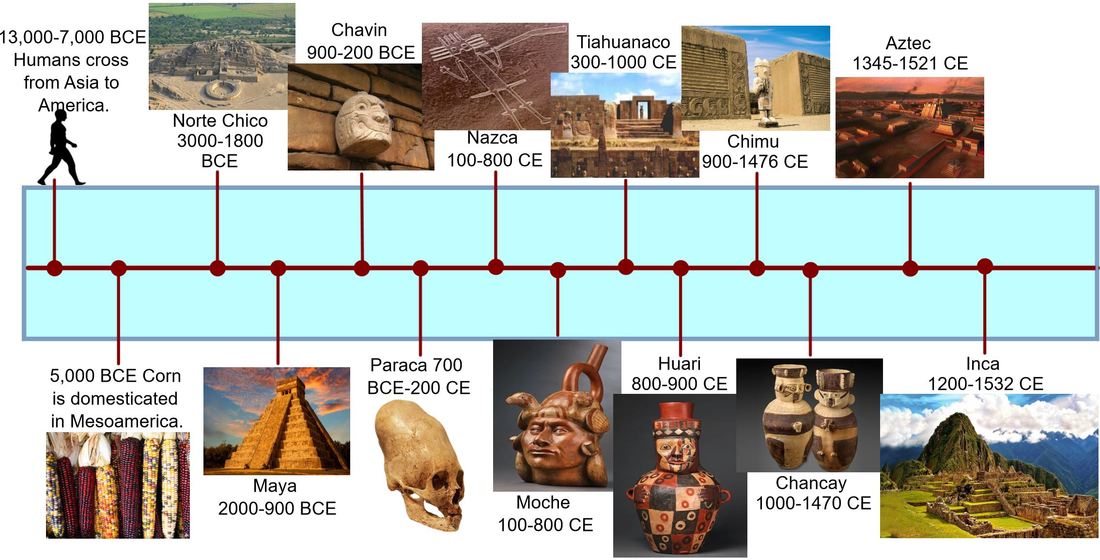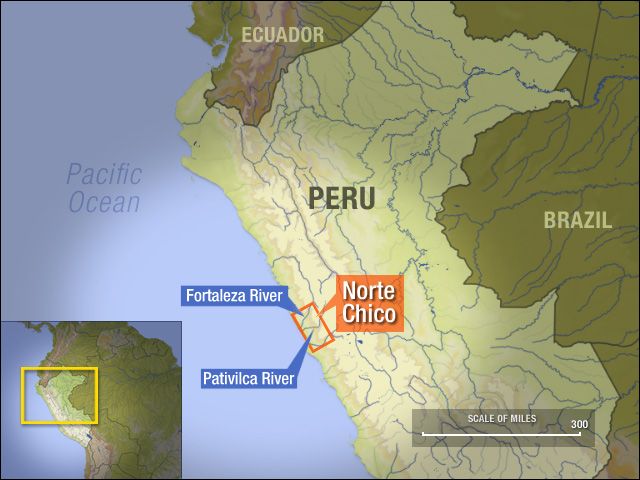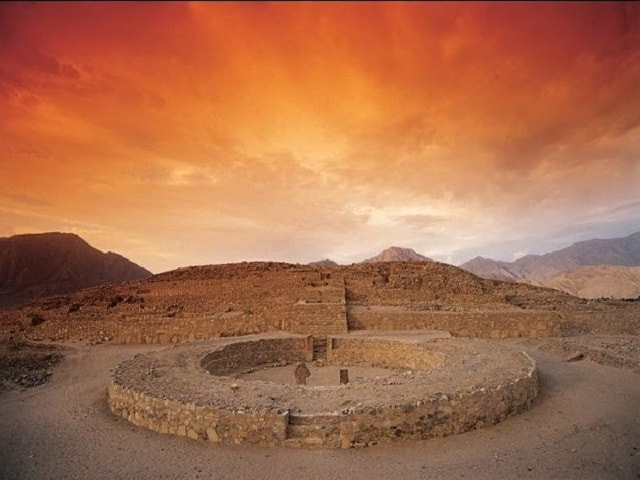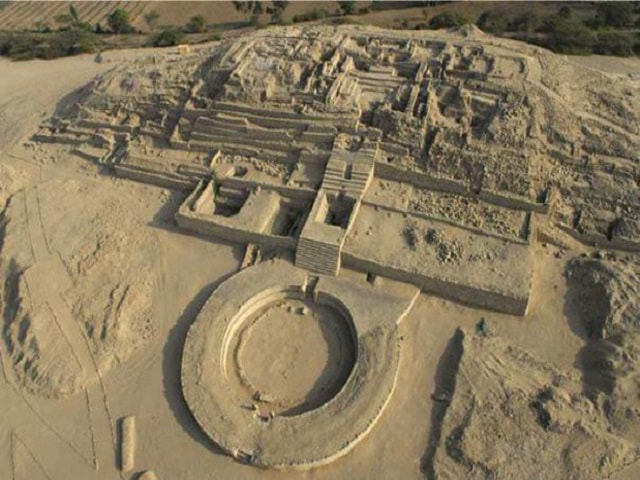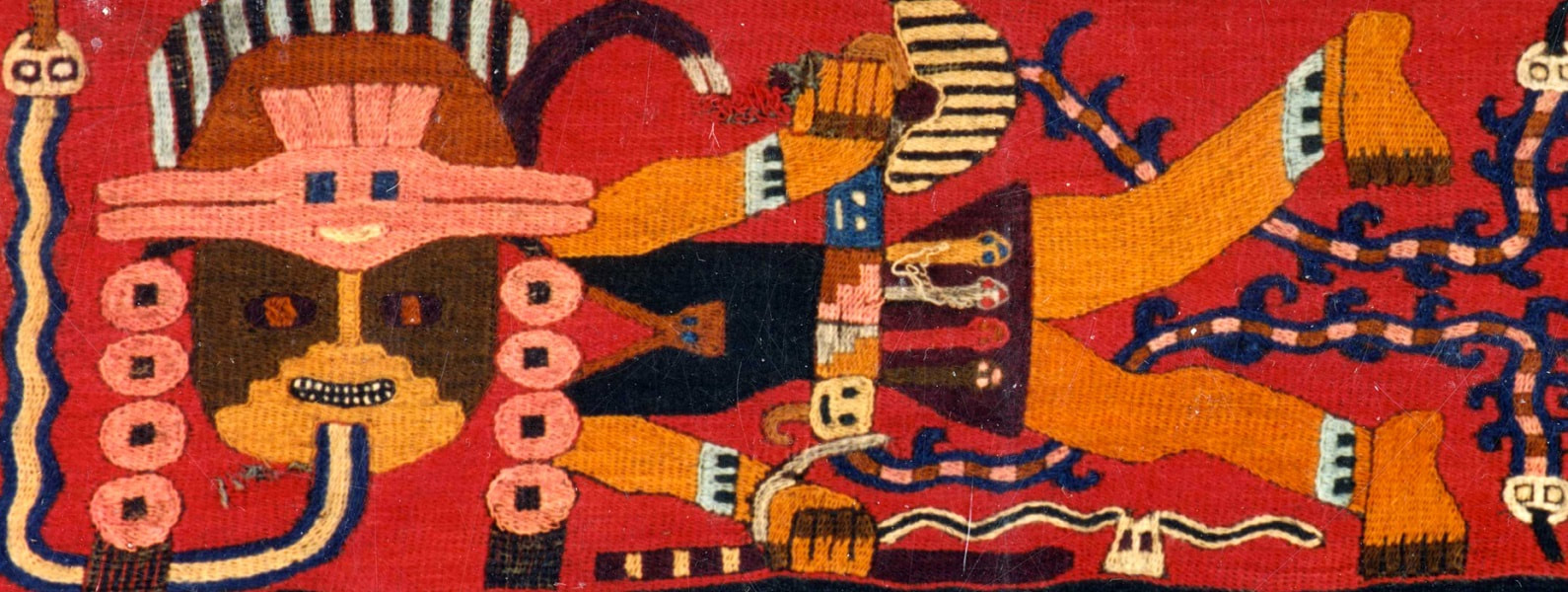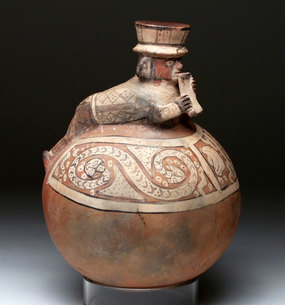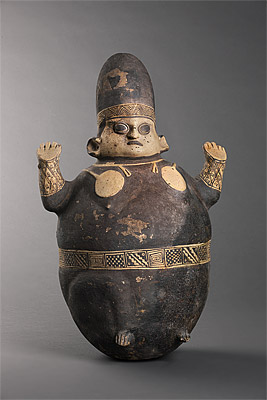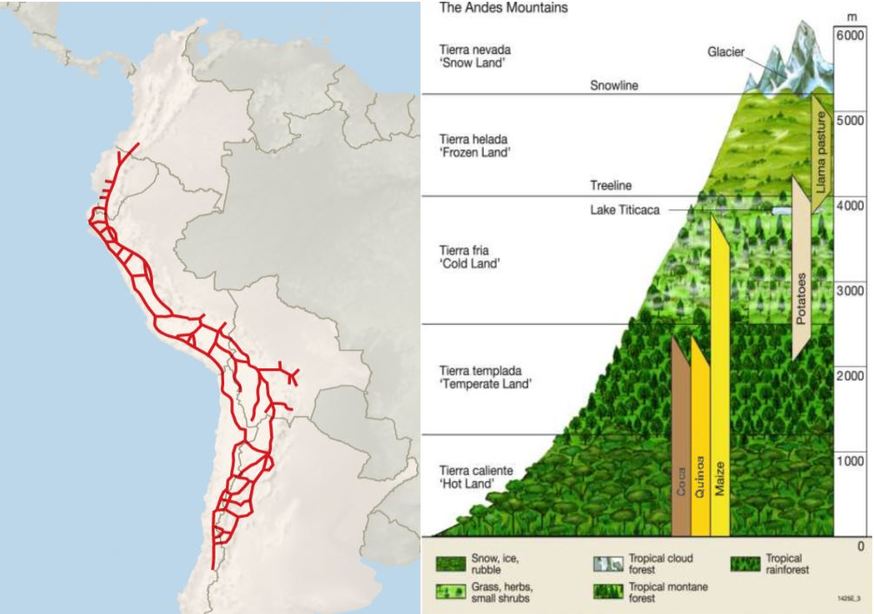Early Settlers and the Hero Pachacuti
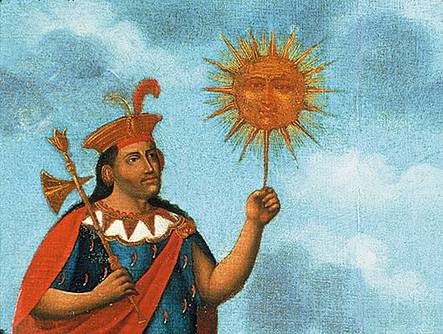
Essential Themes
Conflict & Cooperation: How has warfare shaped human history?
Culture: How do we know what we know about human history?
Conflict & Cooperation: How has warfare shaped human history?
Culture: How do we know what we know about human history?
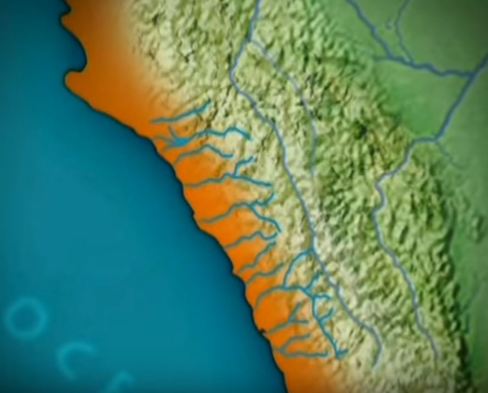
Review: What three natural barriers helped protect the Inca empire from invasion?
The Inca were not the first people to live in the Andes. The earliest people were hunter-gatherers who traveled according to the season and the available supply of food. Before long, those early peoples were not just living in the area, they were settling into villages. As early as 5000 BCE, those villagers were farming the western part of South America.
The early settlers described below were challenged by the geography of the area, for sure. Look at the map of the area to the right. If you were an early settler, where would you want your tribe to put down roots?
Like other ancient cultures, these early settlers worshiped many gods. As time went by, they learned how to work metals and they made beautiful pottery. Eventually, their towns grew into cities. Along with others, the Inca began as just one of many small, South American tribes.
The Inca were not the first people to live in the Andes. The earliest people were hunter-gatherers who traveled according to the season and the available supply of food. Before long, those early peoples were not just living in the area, they were settling into villages. As early as 5000 BCE, those villagers were farming the western part of South America.
The early settlers described below were challenged by the geography of the area, for sure. Look at the map of the area to the right. If you were an early settler, where would you want your tribe to put down roots?
Like other ancient cultures, these early settlers worshiped many gods. As time went by, they learned how to work metals and they made beautiful pottery. Eventually, their towns grew into cities. Along with others, the Inca began as just one of many small, South American tribes.
Norte Chico Civilization (3000 BCE - 1800 BCE): The first civilization to form in the Americas was the Norte Chico civilization of northern Peru. It was one of only six civilizations to form separately in the ancient world. Archeologists think that around 30 major cities were part of the government formed by the Norte Chico, including the capital city of Caral located in the Supe Valley. Looking at their large, well-designed public structures, it's hard to believe that these people mastered the construction of such large scale monumental buildings yet did not have any pottery.
The Norte Chinco were building their monuments at about the same time the Egyptians built their pyramids.
Chavin (900 BCE - 200 BCE): The Chavin lived in the Mosna Valley in the west central part of Peru. They are named after their most well-known site the Chavin de Huantar, which was located high up in the Andes Mountains. The Chavin carved faces of their gods on massive walls of rock. They built a vast complex of temples and tombs at the north end of the Andes. The Chavin culture reached its peak around 500 BCE. In the context of world history, Rome was still a small town at that time.
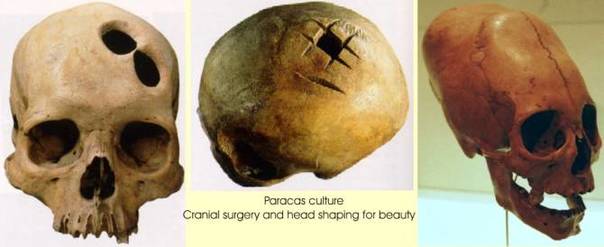
Paraca (700 BCE - 200 CE): The Paraca developed along the coast of Peru. Archaeological evidence of this tribe includes complex, ancient weavings (below), gold, and pottery. Skulls have also been found that show some Paraca practiced cranial elongation. Other skulls show evidence of successful surgery (above). While the Paraca are known for their tombs and well-preserved mummies, they were also skilled farmers who used advanced irrigation techniques to water their crops.
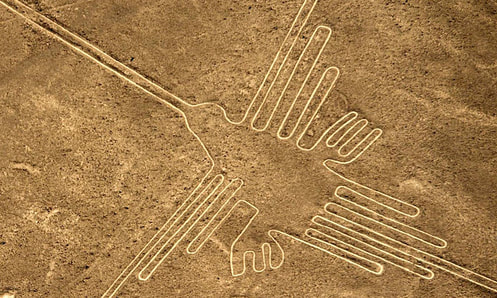
Nazca (100 CE - 800 CE): Long before the Inca, the ancient Nazca culture built an empire in Peru. The Nazca were located along the southern coast of Peru. Their culture was heavily influenced by the Paraca. The Nazca built underground aqueducts and were known for producing beautiful artwork and ceramics. Today the Nazca are most famous for their "Nazca lines". To please their gods, the Nazca made huge figures by carving long lines right into the ground of the dry plateau between the towns of Nazca and Palpa. You can still see these figures today when flying over the land in an airplane. Some of the figures are over 600 feet long! The figures include birds, monkeys, spiders, trees, fish, and llamas. The Nazca created these earthen artworks so that the gods of mountaintops and of the sun and moon could see them. I especially enjoy their fun, brightly painted pottery (shown below) as evidence that the Nazca people connected their lives to nature in a spiritual, joyful way.
Moche (100 CE - 800 CE): At the same time the Nazca were flourishing in the south, the Moche developed along the northern coast of Peru. The center of the Moche civilization was Moche city. Moche city is known for two large structures, the Pyramid of the Sun and the Pyramid of the Moon (Huaca de la Sol & Huaca de a Luna). The Pyramid of the Sun was a huge structure made from over 130 million adobe bricks. Brown and cream Moche pottery was shaped in a most interesting fashion. Archaeologists found a pot that looked like a bird with human hands. Another pot looked like a potato with human eyes.
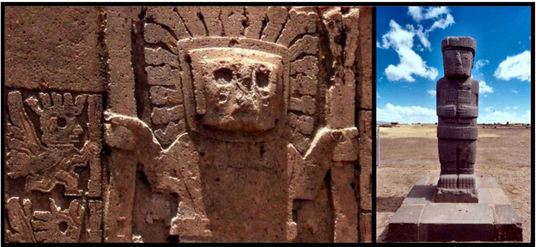 The Tiahuanaco have many representations of Viracocha, the father god for the Inca at their temple complex.
The Tiahuanaco have many representations of Viracocha, the father god for the Inca at their temple complex.
Tiahuanaco (300 CE - 1000 CE) At the center of Tiahuanaco culture was a large city built at 12,000 feet above sea level, high in the Andes Moutains. This city had a large temple complex with huge statues and a famous stone arch called the Gateway of the Sun. It boasted a population estimated at 50,000 people.
Huari (800 CE - 900 CE) The Huari civilization developed to the north of the Tiahuanaco people and had much in common with them. The city of Huari was the center of their empire. The Huari had a central government to whom the Huari people paid taxes. They also developed terraced farming in the mountains and had a well-built road system. The Huari reached their peak around 800 CE. About that time, however, something happened, and their civilization collapsed around 100 years later. Scientists are still puzzled by the Huari collapse.
Chimu (900 CE - 1476 CE): This tribe defeated the Moche Empire and are regarded as the last well-developed culture prior to the rise of the Inca. Their pottery was dark and gloomy. The Chimu built their capital city Chan Chan around 1200 CE. It was a highly planned city that sprawled over ten square miles and included 9 palaces. While today it lays mostly in ruins, it's easy to look at the decorative architecture that remains and imagine the splendor of the city when it bustled with 50,000 Chimu who called it home. During their reign, the Chimu expanded their empire to include much of Peru. In 1476 CE, however, they were conquered by the Inca
Brainbox: What do the early settlers listed above have in common?
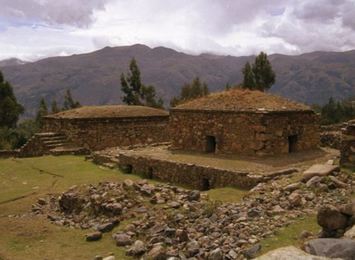 An early Inca village.
An early Inca village.
The Inca
The Inca began as a small band of people living peacefully in the Andes Mountains of South America. They made their capital at Cuzco (KOO-skoh). The leader of the Inca people was known simply as "the Inca" (which means “emperor”) or "Sapa Inca" (which means "lone ruler").
Like the Pharaohs of ancient Egypt, the Inca had absolute rule over his people. That is why his people were called the Inca (the Inca’s people.) The ruling Inca usually treated his people with care. Like most ancient rulers, he lived in luxury. While the people he ruled were hardworking peasants, the royal family had the finest of everything. Mostly, life was peaceful.
The Inca began as a small band of people living peacefully in the Andes Mountains of South America. They made their capital at Cuzco (KOO-skoh). The leader of the Inca people was known simply as "the Inca" (which means “emperor”) or "Sapa Inca" (which means "lone ruler").
Like the Pharaohs of ancient Egypt, the Inca had absolute rule over his people. That is why his people were called the Inca (the Inca’s people.) The ruling Inca usually treated his people with care. Like most ancient rulers, he lived in luxury. While the people he ruled were hardworking peasants, the royal family had the finest of everything. Mostly, life was peaceful.
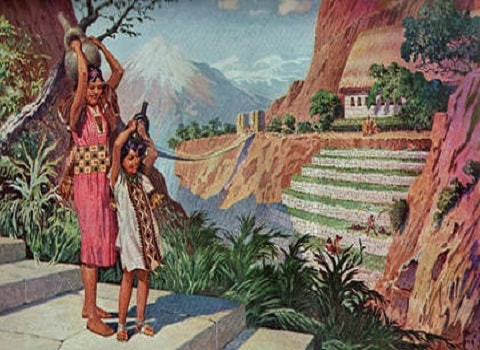
In the beginning, the Inca had no plans to conquer every other tribe. However, in the mid-1400s a ruler named Pachacuti (pah-chah-KOO-tee) led the Inca to expand their territory. Under Pachacuti’s leadership, the Inca empire was born.
The Inca expanded their borders until their empire was one of largest in history. Pachacuti gained territory through agreements with other tribes and through conquest. After Pachacuti, other Inca leaders continued to expand the territory of the Inca empire.
The Inca expanded their borders until their empire was one of largest in history. Pachacuti gained territory through agreements with other tribes and through conquest. After Pachacuti, other Inca leaders continued to expand the territory of the Inca empire.
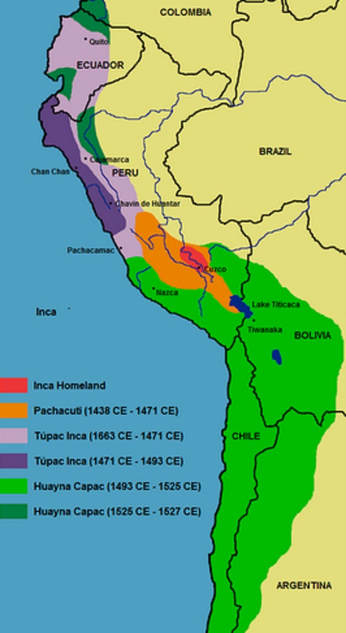
On the map to the left you can see the original territory occupied by the Inca people. It's identified in red. The Inca did not need to expand the region in which they lived to protect themselves from other tribes living in the area. Natural barriers surrounded them. The Andes Mountains alone provided tremendous protection, but they also had the Amazon jungle and the coastal desert. They didn't need to expand to feed their population either. A larger population would only make more demands on farming communities, not less. Yet, in a mere 100 years, the Inca expanded their empire until it grew to be huge. Look at the map to the left one more time. In just 100 years, Inca control expanded from that small red dot to cover the entire west coast of South America. What drove the Inca? Why was expansion so critical to the Inca way of life?
By the early 1500s the Inca Empire was one of the largest in the world. It stretched for 2500 miles from what is now northern Ecuador to central Chile and included coastal deserts, snowy mountains, fertile valleys, and thick forests. Around 12 million people lived in the Inca Empire. To rule this empire, the Inca formed a strong central government.
By the early 1500s the Inca Empire was one of the largest in the world. It stretched for 2500 miles from what is now northern Ecuador to central Chile and included coastal deserts, snowy mountains, fertile valleys, and thick forests. Around 12 million people lived in the Inca Empire. To rule this empire, the Inca formed a strong central government.
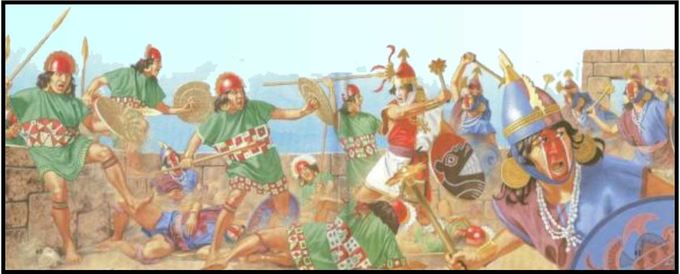
Why did Pachacuti step in to lead the Inca people?
The Hero Pachacuti
The year is 1430 CE. For the first two hundred years of Inca existence, there were some disagreements with neighboring tribes. Life during that time, however, was mostly peaceful.
One day, however, a neighboring tribe started a war with the Inca. This was very upsetting to the Inca ruler at the time. His army was losing badly. In those times in South America, warring tribes usually killed the people they conquered. The Inca ruler, of course, did not wish to die. He convinced himself that if he accepted defeat, the warring tribe might spare the royal family. The Inca ruler knew that even if they did spare the royal family, however, they would still kill most of the common people.
The Hero Pachacuti
The year is 1430 CE. For the first two hundred years of Inca existence, there were some disagreements with neighboring tribes. Life during that time, however, was mostly peaceful.
One day, however, a neighboring tribe started a war with the Inca. This was very upsetting to the Inca ruler at the time. His army was losing badly. In those times in South America, warring tribes usually killed the people they conquered. The Inca ruler, of course, did not wish to die. He convinced himself that if he accepted defeat, the warring tribe might spare the royal family. The Inca ruler knew that even if they did spare the royal family, however, they would still kill most of the common people.
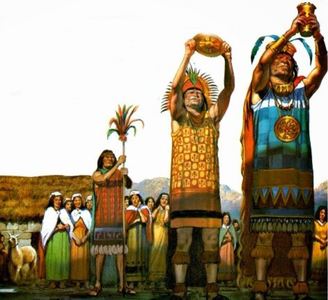
The ruler’s son, Pachacuti, could not believe that his father was considering sacrificing his own people. In Quechan, the Inca language, Pachacuti means "he who overturns space and time" - in other words, "World-shaker." "World-shaker" called on the gods to help him, and then he got to work.
The Inca people believed in a great many gods and goddesses. Like the ancient Greeks, the Inca believed that gods could be counted on to help or to hinder mere mortals in their wars and other earthly affairs. Legend says the gods decided to help Pachacuti save his people.
The Inca people believed in a great many gods and goddesses. Like the ancient Greeks, the Inca believed that gods could be counted on to help or to hinder mere mortals in their wars and other earthly affairs. Legend says the gods decided to help Pachacuti save his people.
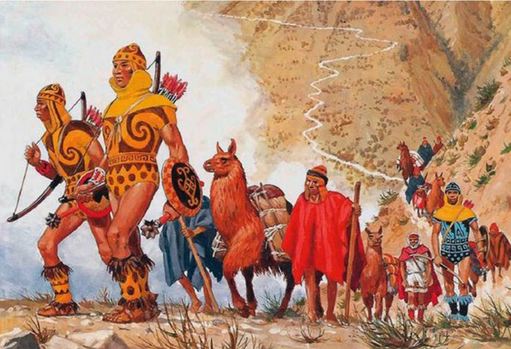
The New Inca
After the battle, Pachacuti crowned himself Inca and replaced his cowardly father as the new leader of the Inca people. Pachacuti turned out to be a great leader. The Inca were saved from total destruction when Pachacuti rebuilt the army, went into battle, and won the day. That was a turning point in Inca history. With that decisive win, the Inca began their transition from a small tribe whose power and reach was limited to the Cuzco Valley to an empire.
Of course, that first victory - never mind empire-building - could not have been accomplished without both the strong leadership of Pachacuti AND a strong army. Indeed, the Inca armies were quite a sight. Their uniforms were very colorful. They marched into battle accompanied by drums, flutes and trumpets. The army was organized, well fed, and well trained. They wore warm clothing and protective headgear. They had plenty of medicine. Their weapons were superior to other neighboring tribes. Their main weapon was a wooden club. They also had bows, spears, and boluses, which were Y-shaped cords with stones at three ends. They believed the gods were on their side. As time went on, some tribes simply joined the Inca empire rather than be defeated in battle. After reading the following account of Pachacuti's army, you might see why:
After the battle, Pachacuti crowned himself Inca and replaced his cowardly father as the new leader of the Inca people. Pachacuti turned out to be a great leader. The Inca were saved from total destruction when Pachacuti rebuilt the army, went into battle, and won the day. That was a turning point in Inca history. With that decisive win, the Inca began their transition from a small tribe whose power and reach was limited to the Cuzco Valley to an empire.
Of course, that first victory - never mind empire-building - could not have been accomplished without both the strong leadership of Pachacuti AND a strong army. Indeed, the Inca armies were quite a sight. Their uniforms were very colorful. They marched into battle accompanied by drums, flutes and trumpets. The army was organized, well fed, and well trained. They wore warm clothing and protective headgear. They had plenty of medicine. Their weapons were superior to other neighboring tribes. Their main weapon was a wooden club. They also had bows, spears, and boluses, which were Y-shaped cords with stones at three ends. They believed the gods were on their side. As time went on, some tribes simply joined the Inca empire rather than be defeated in battle. After reading the following account of Pachacuti's army, you might see why:
Seated on a shimmering litter, Pachacuti gave his army the order to attack. Playing panpipes carved from the bones of enemies and war drums made from the flayed skins of dead foes, his soldiers advanced toward the enemy, a moving wall of terror and intimidation. When the fog of battle lifted, the land had disappeared beneath the dead bodies of the Inca enemy.
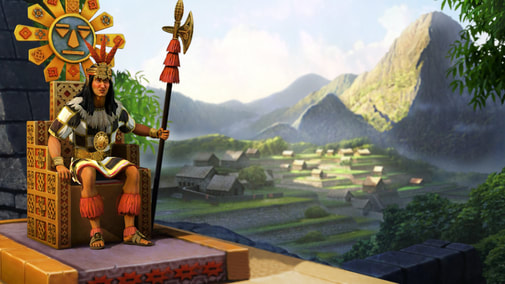
In the years that followed Pachacuti's first victory, he and his descendants defeated all the tribes in the basin of Lake Titicaca to the south. Military victory, however, was only the first step in Pachacuti's grand strategy of empire building.
With each military victory, Inca officials set about establishing control of their newly won provinces. If provinces resisted, Inca rulers shuffled their populations, moving unruly inhabitants to the Inca heartland and replacing them with loyal subjects.
Residents of remote walled villages were moved to new Inca-controlled towns nearer to Inca roads. Placing unruly residents near the Inca roads meant that Inca troops could easily rush to the site of any potential uprising. Inca governors ordered the construction of roadside storehouses for those troops and commanded local communities to fill them with supplies. Such planning leads many to think of the Inca as organizational geniuses. Conquest led to power - and wealth - and the organization of their empire led to peace.
Under Inca organization, Andean civilization blossomed. Inca engineers transformed isolated roads into interconnected highways. Inca farmers mastered high-altitude, Andean agriculture. The Inca grew over 70 different native crops. Inca farmers were so successful that the empire was able to stockpile three to seven years’ worth of food. They kept those surpluses in storage complexes throughout the empire so that, in times of need, food could quickly be distributed to the Inca people. Though the Inca did not have a written language, government officials mastered the art of inventory control. They were able to track storehouse contents across the empire with an ancient Andean form of computer code - colored and knotted cords known as quipus (kee-poos).
With each military victory, Inca officials set about establishing control of their newly won provinces. If provinces resisted, Inca rulers shuffled their populations, moving unruly inhabitants to the Inca heartland and replacing them with loyal subjects.
Residents of remote walled villages were moved to new Inca-controlled towns nearer to Inca roads. Placing unruly residents near the Inca roads meant that Inca troops could easily rush to the site of any potential uprising. Inca governors ordered the construction of roadside storehouses for those troops and commanded local communities to fill them with supplies. Such planning leads many to think of the Inca as organizational geniuses. Conquest led to power - and wealth - and the organization of their empire led to peace.
Under Inca organization, Andean civilization blossomed. Inca engineers transformed isolated roads into interconnected highways. Inca farmers mastered high-altitude, Andean agriculture. The Inca grew over 70 different native crops. Inca farmers were so successful that the empire was able to stockpile three to seven years’ worth of food. They kept those surpluses in storage complexes throughout the empire so that, in times of need, food could quickly be distributed to the Inca people. Though the Inca did not have a written language, government officials mastered the art of inventory control. They were able to track storehouse contents across the empire with an ancient Andean form of computer code - colored and knotted cords known as quipus (kee-poos).
With such efficient control, Pachacuti did not always need to use warfare to expand his empire. Often, Pachacuti sent spies to regions he wanted to bring under his control. His spies would report back on the political organization, military might, and wealth of the area. Pachacuti would then send messages to the leaders of those lands explaining the benefits of joining his empire. Along with the messages, he sent them presents of luxury goods such as the finest Inca textiles and promised that they would be far richer as subjects of the Inca than if they stood alone in opposition to the Inca. Rather than go to war with the fierce Inca army, most leaders accepted the rule of the Inca and gave in peacefully.
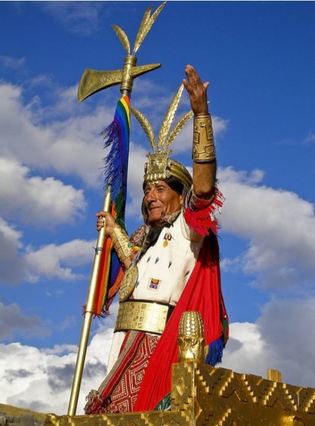
In time, Pachacuti did not need to kill the people he conquered. Instead, he simply invited them to become part of the Inca empire. In return for their joining the empire, he built schools, as well as fabulous cities and fortresses. He placed his royal relatives in positions of power in the government throughout the empire. The Inca rulers who followed him did the same. At the height of their power, the Inca empire was 2500 miles long, 500 miles wide, and home to 12 million people. These people called themselves “The Children of the Sun.”
Land of the Four Quarters.
The land the Inca ruled their capital city, Cuzco became known as the “Land of the Four Quarters.” It was named that because the Inca empire was divided into four parts for ruling purposes.
Land of the Four Quarters.
The land the Inca ruled their capital city, Cuzco became known as the “Land of the Four Quarters.” It was named that because the Inca empire was divided into four parts for ruling purposes.
Brainbox: Why do you think Pachacuti spared the lives of the peoples he conquered?

